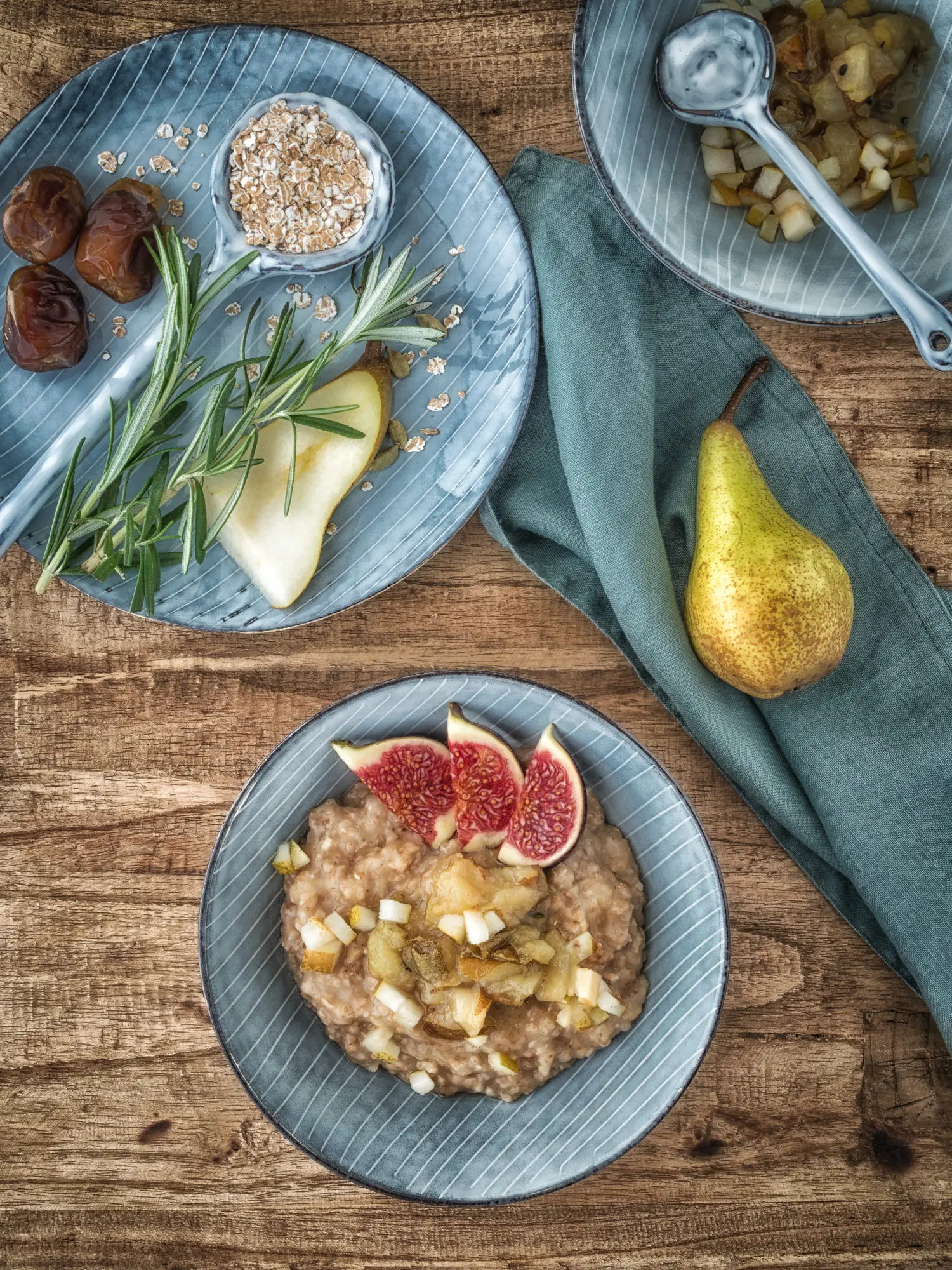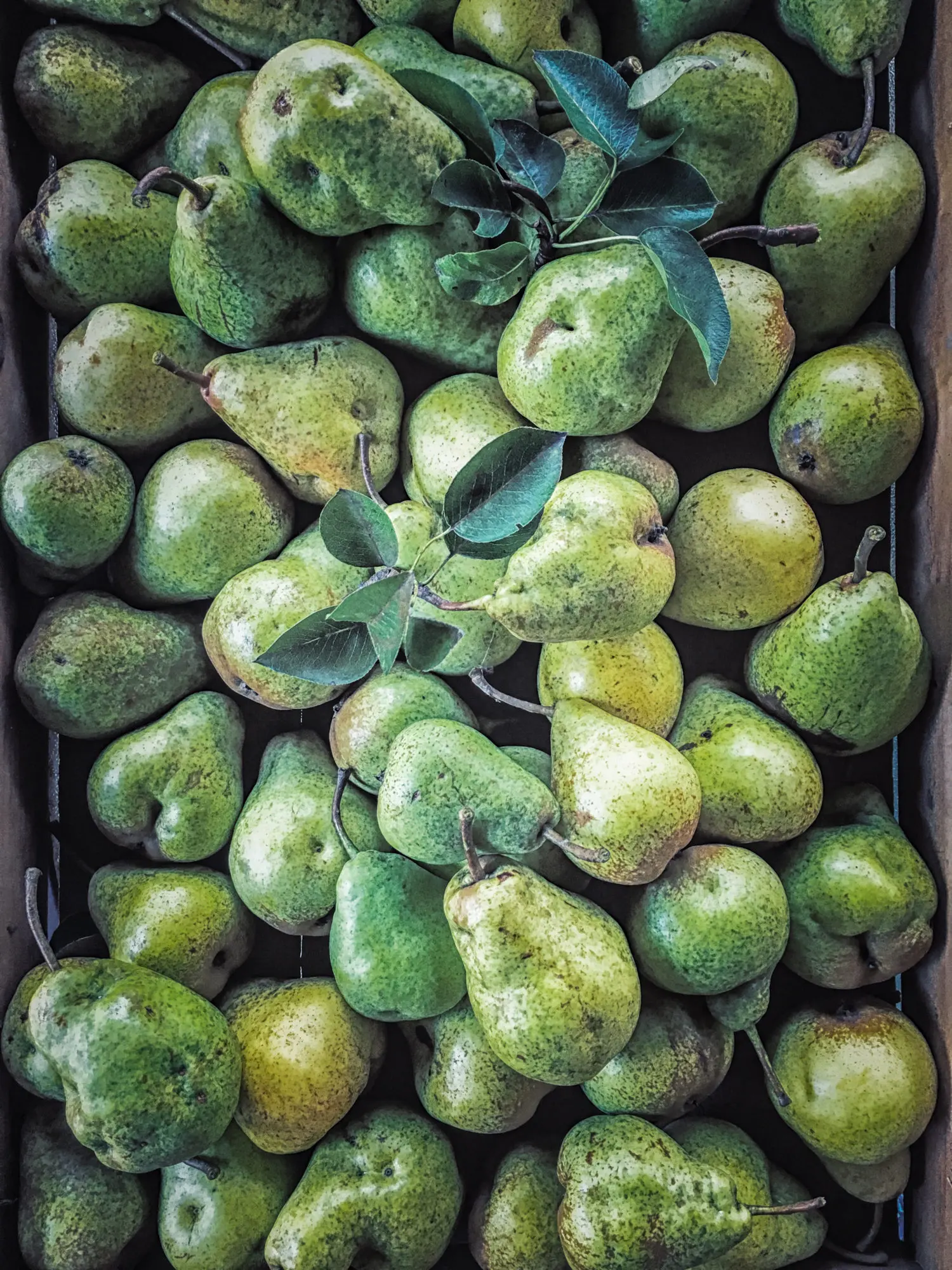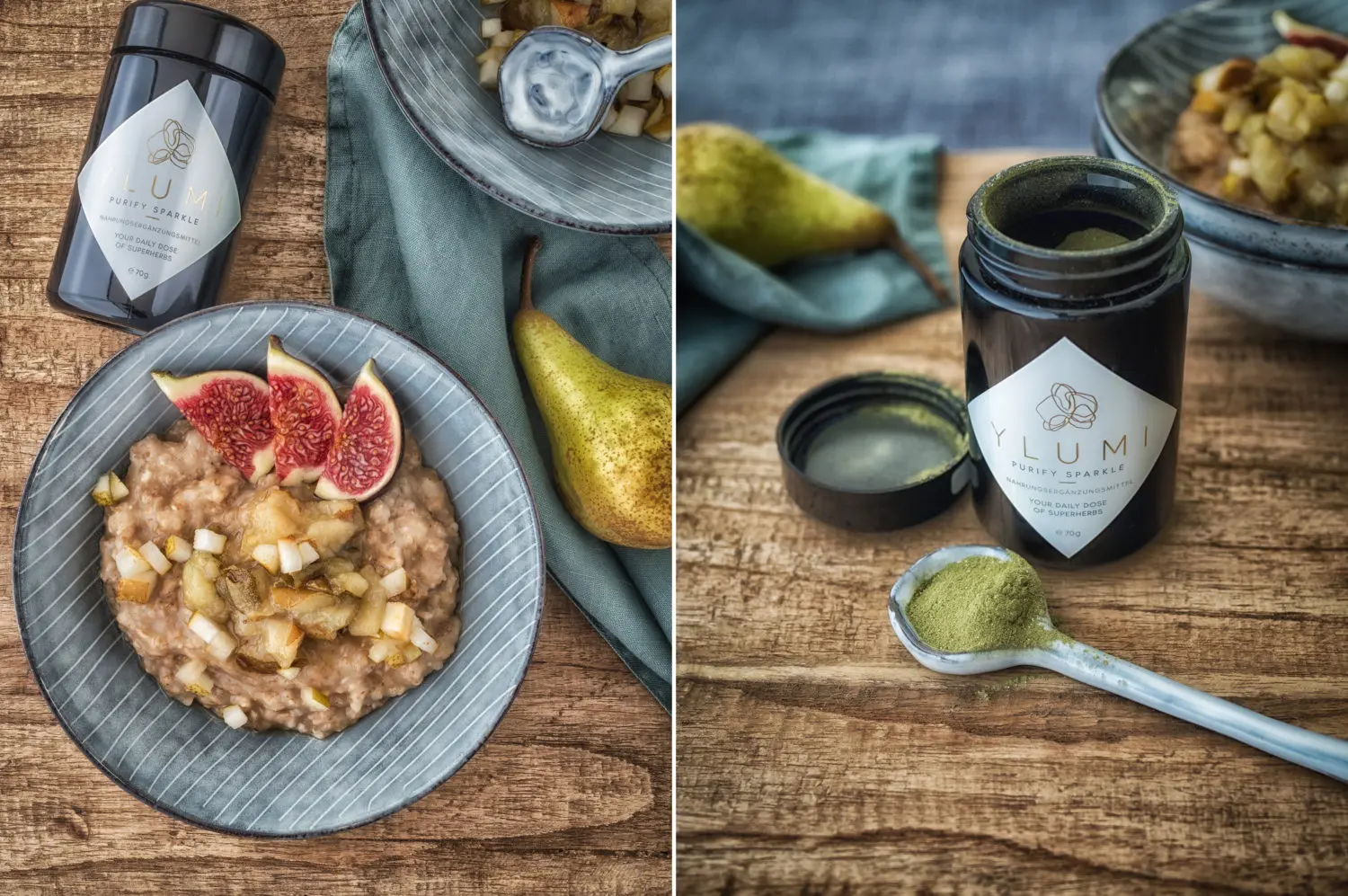
Ach, der Herbst und all seine wundervollen Farben, Gerüche und Aromen. Während ich früher nie genug vom Sommer bekommen konnte, bin ich mittlerweile ein echter Herbst Fan. Auch wenn er hier im Norden oft regnerisch und grau daher kommt, die Tage an denen er sich in all seiner Pracht zeigt -mit bunten Blättern und Sonnenschein- geniesse ich dann umso mehr.
Vor allem die vielen Obst- und Gemüse Sorten die der Herbst mit sich bringt, haben es mir angetan.
Ich kann immer kaum den August abwarten bis die Birnen Saison wieder beginnt und Gute Luise, Williams Christ und Gellerts Butterbirne wieder in den Auslagen der Marktstände liegen.

Am Liebsten kombiniere ich Birnen im Herbst mit Getreide. So ein warmes Porridge am Morgen oder auch zum Mittagessen ist einfach unschlagbar, wenn es draussen kälter wird. Je nach Stimmung verfeinert mit verschiedenen Gewürzen, sind da der Kreativität keine Grenzen gesetzt.
Dinkel Porridge mit Birnen Kompott
Für mein heutiges Rezept habe ich auf meine liebsten Gewürze überhaupt zurück gegriffen: Rosmarin, Kardamom und Vanille, abgerundet mit ein wenig Tonkabohne. Wer jetzt denkt, dass Rosmarin nur etwas für herzhafte Gerichte ist, dem sei versichert: es schmeckt ganz wunderbar in Süßspeisen. Das sich mit Rosmarin sogar ganz wunderbar backen lässt, kannst du an meinem Rezept für Apfelkuchen mit Rosmarin sehen, auch einer der Klassiker bei uns im Herbst.

Aber zurück zum Porridge. Ich mache es, wie auch die Milch mit der es zubereitet wird, aus Dinkel Flocken. Dabei verwende ich das Feinblatt, einfach weil ich es lieber mag. DU kannst natürlich Flocken deiner Wahl verwenden. Ganz egal ob Hafer, Emmer, Kamut oder Reis. Sie alle schmecken köstlich zu meinem Birnen Kompott mit Rosmarin und Kardamom.
Von den Gewürzen abgesehen, braucht es nur wenige Zutaten: ein wenig Süße, ein wenig Salz und eben die Flocken, und du hast Ruck Zuck ein wundervoll nahrhaftes Gericht.

Dinkel Porridge mit Birnen-Rosmarin Kompott

Dieses Rezept ergibt 2 große Portionen Dinkel Porridge, sowie einen Liter Dinkel Milch.
Für die Milch:
- 100 gr Dinkelflocken
- 1 Liter Wasser
- 4 Datteln
- 1 Prise Salz
Für das Birnen-Rosmarin Kompott
- 400 gr frische Birne
- 2 EL Ahornsirup
- ca 6 Kardamom Samen
- 2 Stengel frischen Rosmarin
- eine Prise Salz
Für das Porridge
- 150 gr Dinkelflocken
- 600-800 ml Dinkelmilch
- eine Prise Salz
- 1-2 EL Ahornsirup
- etwas Abrieb einer Tonkabohne
Dinkelmilch:
- Für die Dinkelmilch einfach alle Zutaten in einen Mixer geben und gründlich durchmixen. Wenn keine Stücken mehr zu sehen sind, alles durch einen Nussmilchbeutel oder ein ganz feines Passiersieb giessen.
- In eine Flasche füllen und beiseite stellen.
Birnen-Rosmarin Kompott:
- Die Birnen in gleichmäßige Würfel schneiden, dabei ruhig die Schale dran lassen.
- Die Kardamom Samen in einen trockenen Topf geben und solange sanft rösten bis sie einen feinen Kardamom Duft verströmen.
- Dann den Ahornsirup und den Rosmarin zugeben und alles 1-2 Minuten karamellisieren lassen.
- Die Birnen hinzugeben und bei zugedecktem Topf ca 10- 15 Minuten auf mittlerer Hitze leicht köcheln lassen.
- Gelgentlich umrühren und die Farbe des Rosmarin kontrollieren. Wenn dieser seine grüne Farbe verloren hat, raus nehmen. Er wird sonst bitter.
- Das Kompott köcheln lassen, bis es die gewünschte Konsistenz erreicht hat.
Dinkel Porridge
- Für das Porridge 150 gr Dinkelflocken in einem großen trockenen Topf leicht anrösten.
- ml Dinkelmilch hinzugeben und gut verrühren.
- Während das Porridge köchelt etwas Salz, sowie etwasa Abrieb einer Tonkabohne dazugeben.
- Das Porridge ca 10 Minuten köcheln lassen, dabei immer wieder umrühren und bei Bedarf mehr Milch hinzugeben.
- Wenn das Porridge eine dir angenehme Konsistenz erreicht hat, alles auf Schüsseln aufteilen, mit dem Birnen Kompott servieren und geniessen!
Ich toppe das Dinkel Porridge oft noch mit etwas Cashewmus oder -grade wenn ich leicht erkältet bin- mit einer extra Portion Superfoods. Mein Favorit im Moment ist das Purify Sparkle von Ylumi. Eigentlich ein Zusatz für Getränke und Smoothies macht es sich aber auch in Porridge ganz fein. Es enthält u.a. das Extrakt des Agaricus Blazei Murill, auch Mandelpilz genannt. Dieser hat in klinischen Studien seine Wirksamkeit bei einem geschwächten Immunsystem bewiesen und kann Linderung bei diversen Krankheiten wie Allergien, Fibromyalgie, Multipler Sklerose, Alzheimer, Morbus Parkinson sowie Rheuma bewirken.

Neben dem Mandelpilz enthält das Pulver noch allerlei Gutes, wie zu Beispiel Kurkuma, Biotin, Ginseng, Moringa, Spirulina und Vitamin B. Ich verwende es regelmäßig und merke auf Dauer auf jeden Fall eine Verbesserung in puncto Müdigkeit, Stressresistenz und einem widerstandsfähigerem Immunsystem.
Bei meinen Freunden von Ylumi gibt es auch noch diverse andere Sorten, alles speziell für einen besonderen Zweck formuliert. Schau mal bei Ylumi vorbei, falls dich das Thema interessiert.
Dort kannst du auch mehr zum Thema TCM lesen, ein super interessantes Thema, dem ich mich hier auf dem Blog in Zukunft auch des Öfteren widmen werde.
Wer aber einfach nur Lust auf richtig gutes Porridge hat, der geniesst es einfach Pur und freut sich über die wunderbare Kombination der Aromen und das wohlig warme Gefühl, das so ein leckeres Dinkel Porridge hinterlässt.
Ach, und wenn du Porridge undGewürze so sehr magst wie ich, dann probier unbedingt auch meinen Gewürz Porridge mit Kürbiskernen und Sauerkirschen.




Liebe Stephanie,
Tolle Fotos, die du geschossen hast! Auch das Rezept hört sich lecker an! Ich bin kurz gestolpert, weil du bei der Beschreibung die ml Zahl der Dinkelmilch vergessen hast – bin aber fündig geworden 🙂
Viele Grüße, Izabella
P.S.: Deinen Pin habe ich bei Pinterest geteilt – Ich hoffe, das war ok 🙂
Liebe Izabella,
herzlichen Dank für dein liebes Feedback. Und danke für den Hinweis, ich ändere das gleich mal ab. Toll, dass du meinen Pin geteilt hast, das freut mich sehr 🙂
Ein tolles Wochenende für dich !
Stephanie
Hallo liebste Stephanie,
Ich finde dich und deinen Blog und deine Rezepte einfach toll und habe am Samstag den Blaubeeren Rawcake gemacht. Obwohl er so klasse schmeckt ist noch was übrig und ich wollte wissen, wie lange ich so einen cake im Kühlschrank aufbewahren kann. Ich hatte ihn ursprünglich im TK und wollte ihn da auch stückweise lassen, aber er war so hart dass ich ihn nicht mehr schneiden konnte. Jetzt steht er im Kühlschrank noch 3 Stücke sind übrig und ichbweiss nicht ob ich ihn wieder einfrieren kann oder wie lange er sich hält. Danke für deine Antwort. Grüße von Petra
Hallo Petra,
Also wenn er schon geschnitten ist, dann kannst du ihn ruhig wieder einfrieren. Der hält sich ewig.
Ich schneide meine Kuchen immer komplett und friere sie dann ein.
Klappt super !
Ganz liebe Grüße
Stephanie